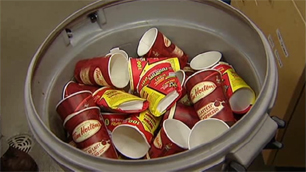
Microbiologists Richard Sparling and David Levin said they came up with the idea of using the paper cups after walking past some of the four Tim Hortons outlets on campus.
"We see a lot of cups being thrown away," Sparling said. "Knowing that these are not sent away for any type of recycling at this time, we thought ... they would make excellent food for the bacteria that we use to make biofuels such as ethanol or even hydrogen."
Since starting the project "on a whim" in 2009, they've had some promising results: they have found they are able to generate about 1.3 litres of ethanol from about 100 Tim Hortons cups.
They're hoping that will eventually lead to more sustainable sources of ethanol, widely used as a gasoline additive and alternative fuel for cars.
Right now, ethanol is mainly produced from food crops such as corn and wheat, but that displaces food production and pushes up food prices.
Researchers are looking into alternative sources, particularly those based on cellulose, a fibrous material found in wood, stems and leaves. That involves turning materials such as wood chips and wheat straw into sugars that bacteria can digest using processes like steam explosion and acid treatment.
"That takes a tremendous amount of energy and money," Levin said.
Microbiologist David Levin holds up a vessel containing bacteria that turn paper into ethanol as colleague Richard Sparling looks on. The researchers say there is a lot of interest in sources of biofuels that aren't food crops. (CBC)Tim Hortons cups and other paper products have already been pre-treated and processed into a bacteria-ready form and are an abundant waste material.
"We have so much biomass that it would be a shame not to use it," Sparling said.
Sparling and Levin collect the raw materials for their research by setting up bins outside campus Tim Hortons outlets. The cups are brought back to the lab, where they are put through a paper shredder and eventually converted into a mulch resembling pink cotton candy. That increases the surface area that the bacteria can latch onto in order to start munching, speeding up the process.
The mulch is loaded into a bioreactor, where the environment, including the temperature and pH, is controlled to make the bacteria comfortable and help them process the mulch efficiently. Then the bacteria are added, and they go to work.
In the process of using our waste as fuel, they generate their own waste - ethanol and hydrogen, along with some acetic acid and carbon dioxide - that we can use as fuel.
Bacteria prefer Tim Hortons to Starbucks
The researchers have tried using cups from brands other than Tim Hortons and found the bacteria have their favourites.
"They like the Tim Hortons cups better than the Starbucks cups," Levin said. "It's not that they don't like the Starbucks; it just takes them a little bit longer to break them down and convert them."
He added that has to do with the specific recipe for the paper used by the manufacturer that supplies the cups to each company.
The researchers estimate it will take about three to five years more work to develop a process for turning cups into fuel that could be commercialized, but warn it could be slow because they haven't received any funding dedicated to the project.
They have been in talks with Tim Hortons officials, who say they're excited about the project but haven't yet offered to help fund it.



Reader Comments
to our Newsletter